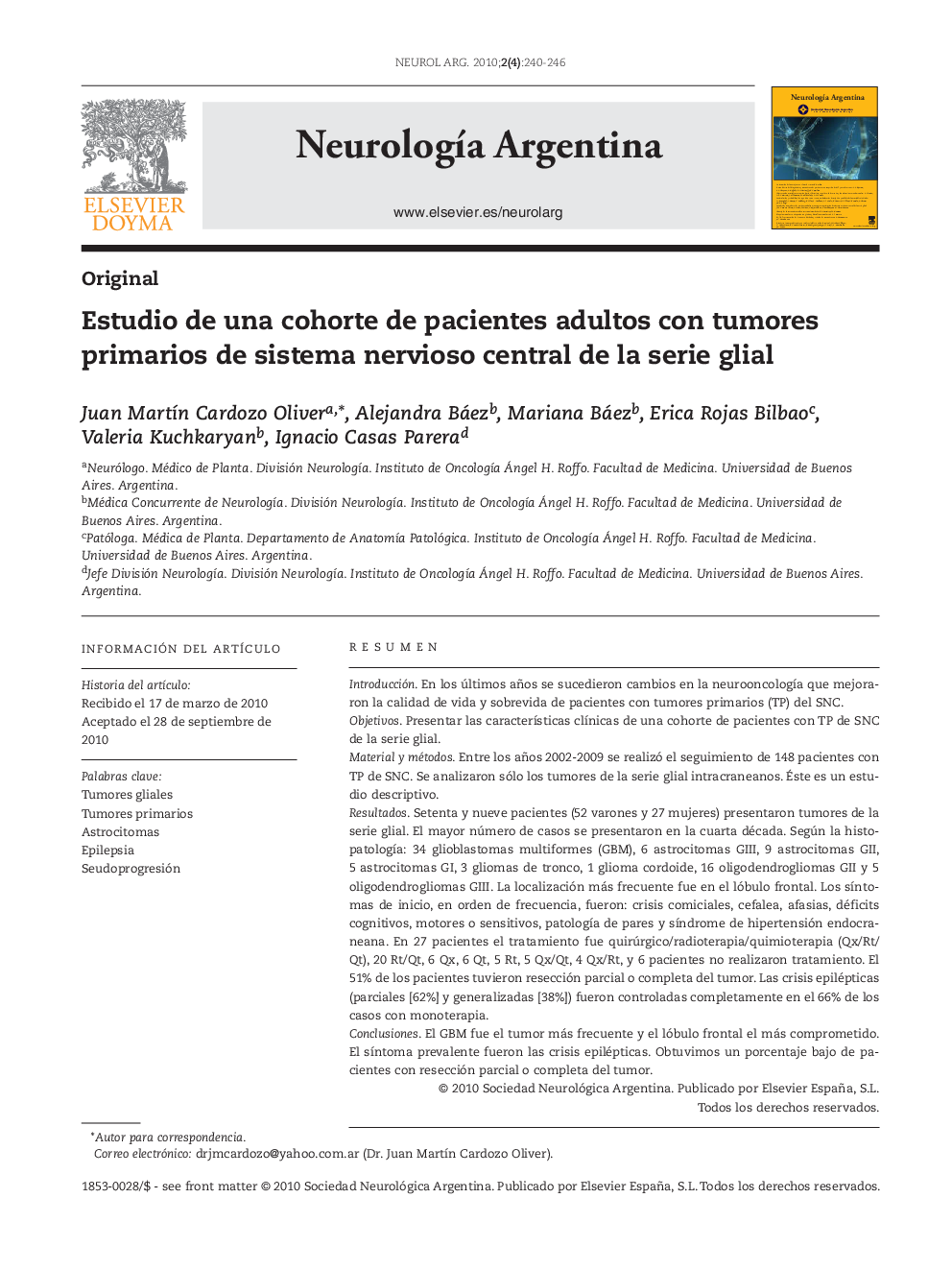| Article ID | Journal | Published Year | Pages | File Type |
|---|---|---|---|---|
| 3076925 | Neurología Argentina | 2010 | 7 Pages |
ResumenIntroducciónEn los últimos años se sucedieron cambios en la neurooncología que mejoraron la calidad de vida y sobrevida de pacientes con tumores primarios (TP) del SNC.ObjetivosPresentar las características clínicas de una cohorte de pacientes con TP de SNC de la serie glial.Material y métodosEntre los años 2002-2009 se realizó el seguimiento de 148 pacientes con TP de SNC. Se analizaron sólo los tumores de la serie glial intracraneanos. Éste es un estudio descriptivo.ResultadosSetenta y nueve pacientes (52 varones y 27 mujeres) presentaron tumores de la serie glial. El mayor número de casos se presentaron en la cuarta década. Según la histopatología: 34 glioblastomas multiformes (GBM), 6 astrocitomas GIII, 9 astrocitomas GII, 5 astrocitomas GI, 3 gliomas de tronco, 1 glioma cordoide, 16 oligodendrogliomas GII y 5 oligodendrogliomas GIII. La localización más frecuente fue en el lóbulo frontal. Los síntomas de inicio, en orden de frecuencia, fueron: crisis comiciales, cefalea, afasias, déficits cognitivos, motores o sensitivos, patología de pares y síndrome de hipertensión endocraneana. En 27 pacientes el tratamiento fue quirúrgico/radioterapia/quimioterapia (Qx/Rt/Qt), 20 Rt/Qt, 6 Qx, 6 Qt, 5 Rt, 5 Qx/Qt, 4 Qx/Rt, y 6 pacientes no realizaron tratamiento. El 51% de los pacientes tuvieron resección parcial o completa del tumor. Las crisis epilépticas (parciales [62%] y generalizadas [38%]) fueron controladas completamente en el 66% de los casos con monoterapia.ConclusionesEl GBM fue el tumor más frecuente y el lóbulo frontal el más comprometido. El síntoma prevalente fueron las crisis epilépticas. Obtuvimos un porcentaje bajo de pacientes con resección parcial o completa del tumor.
BackgroundIn recent years there have been changes in neurooncology that have improved quality of life and survival for patients with primary CNS tumors (PCNST).ObjectivesTo present the clinical features of a cohort of patients with primary CNS glial tumors.Materials and methodsOne hundred and forty-eight patients with PCNST were followed up between 2002 and 2009. Only glial type PCNST was studied. This is a descriptive study.ResultsSeventy-nine patients (52 males and 27 females) presented glial type PCNST. In most of the cases, tumors appeared in the fourth decade. Glioblastoma multiforme (GBM) 34, GIII astrocytoma 6, GII astrocytoma 9, GI astrocytoma 5, brainstem glioma 3, chordoid glioma 1, GII oligodendroglioma 16 and GIII oligodendroglioma 5 were diagnosed according to the WHO histological tumor classification. The frontal lobe was the most frequent location. Initial symptomatology in order of frequency was: seizures, headache, aphasia, cognitive impairment, motor weakness, sensorial deficits, cranial nerve involvement and intracranial hypertension syndrome. Surgery/radiotherapy/chemotherapy (Sx/Rt/Cht) was performed in 27 patients; Rt/Cht 20, Sx 6, Cht 6, Rt 5, Sx/Cht 5, Sx/Rt 4 and 6 patients were not treated. Partial or complete tumor resection occurred in 51% of patients. In 66% of the cases, the epileptic seizures (62% partials, 38% generalized) were succesfully controlled with monotherapy.ConclusionsGBM was the most frequent tumor, and the frontal lobe was the most affected. Seizures were the prevalent symptom. We observed a suboptimal percentage of patients with partial or complete tumor resection.
